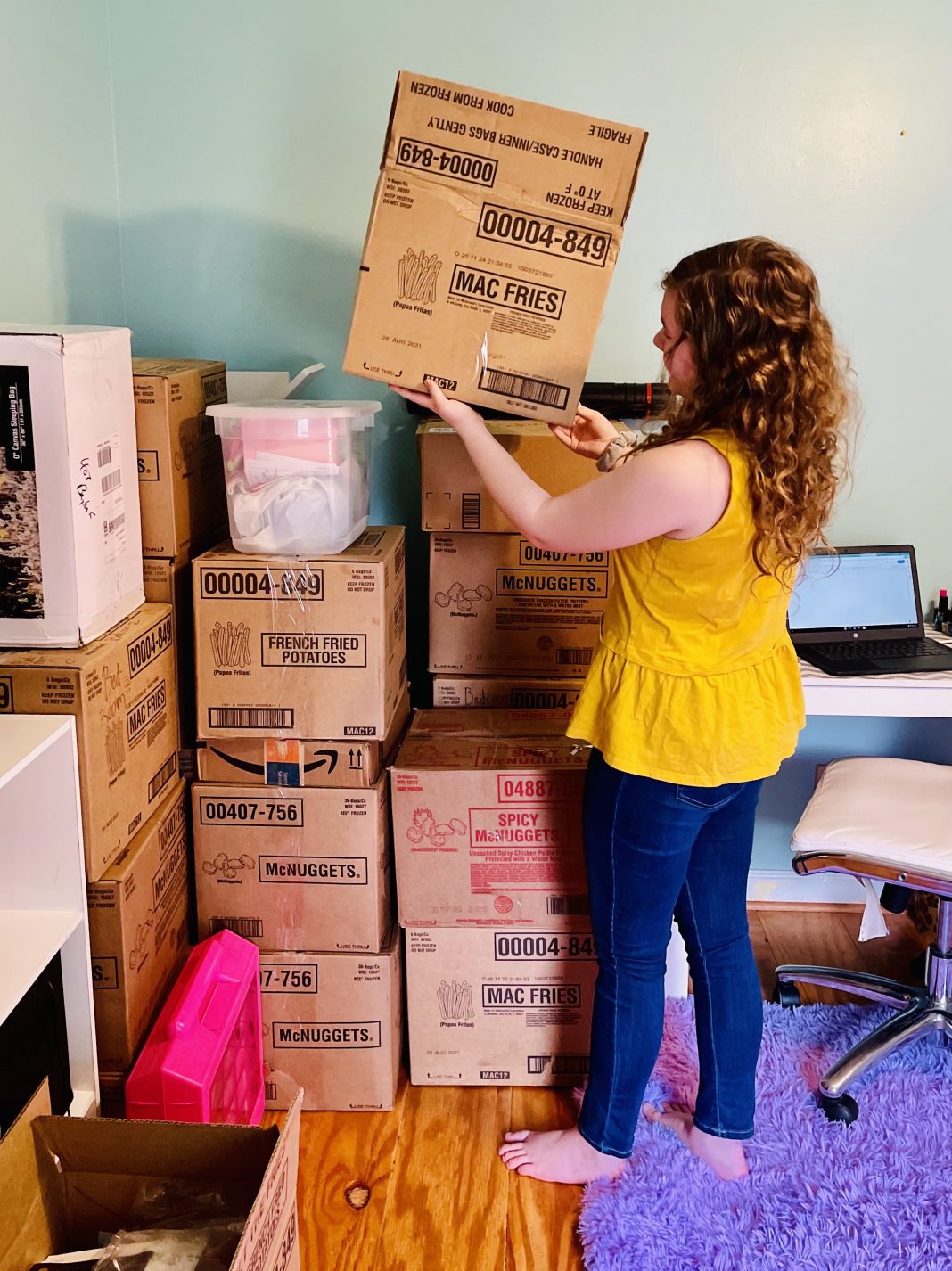Moving with Kids? Here’s What You Need to Know
Each year an estimated 11% of the US population moves with 50% of relocations occurring in the summer, according to the American Moving and Storage Association.
Moving a family to a new city is an exciting but sometimes overwhelming process. Adults can quickly list the positive and exciting opportunities that result from it. Kids on the other hand, might not be able to do this easily.
Memories of my happy childhood are segmented into 3- or 4-year periods, because we moved often. We finally settled in West Virginia near my grandmothers. I stayed for a few years, then moved to sunny Florida for graduate school. I can attest to the fact that children need different tools to cope with the changes of moving.
Years later when I moved my own two young girls, I noticed how differently they felt about the move. The 5 year old was excited and motivated to jump into a new home and city. My 7 year old felt a loss of control, the loss of relationships, activities, and loss of everything familiar.
If you are considering a move and children are involved, keep this list handy for strategies I used as a child and as a mom when relocating my own family. I offer these tips to my real estate clients and constantly learn from the experiences of others.
Plan Ahead
Map out and prepare as much as you can before moving day. Kids thrive with stability and predictability.
✔ Start packing a little every day as soon as you know you are moving so you are not overwhelmed.
✔ Research your new community, schools, daycare, activities, etc. You want to give your children as many solid facts to rely on and mentally prepare for.
✔ Is the culture or language different in the new location? What do people in this new area value?
✔ Plan a moving day for your child in an age-appropriate way. Find a sitter for your youngest children. For older kids arrange for a long playdate at their best friend’s home to enjoy as much quality time with them before the move.
✔ Organization – Color code the tape or marker on the box with the room it goes to in the new home. For example, I placed red duct tape and wrote in red marker on the boxes for my oldest child’s room. Before the movers arrived in the new house, I placed a red card on the door to her room. My youngest child chose a different color. Kids of all ages can assist to varying degrees.
✔ Plan a time to return to the old community to visit family, friends & neighbors. If that’s not possible, plan a Facetime or Zoom call. With all the new surroundings, it will be comforting to see familiar faces. Let your kids share their new room or backyard on the call too. This will teach your children how to maintain important long-distance relationships.
Involve the Kids
To whatever degree is appropriate for their age, allow them to be a part of the preparation, decision making, and exploration of the new community. Talk with them about your plans. Listen to their thoughts, concerns, and do your best to answer their questions.
Preschool – Explain in very simple terms what will happen.
✔ Explain that their favorite belongings will go with them to the new house, even the furniture.
✔ Show them photos of their new house or room.
✔ Talk about the fun things you can do when you settle into the new place.
✔ Read to them using a picture book with cute characters who explain moving in positive terms (ie. Daniel Tiger’s Neighborhood – Moving To The Neighborhood by Alexandra Cassel)
Elementary – Explain in simple terms and welcome their active involvement in the process.
✔ They can assist with packing. Do the more complicated packing while they’re in bed or at school.
✔ Invite them to tour the new home & community, if possible. If not, use the Internet. Get them excited about what they’ll be able to do.
✔ Find age-appropriate books or workbooks to help them process the changes (ie. My Very Exciting, Sorta Scary, Big Move: A Workbook for Children Moving to a New Home by Lori Attanasio Woodring).
✔ Listen and talk with them about their concerns related to the changing nature of their world and friendships. Talk with them about how you’ll help them stay in touch with family & friends ie/visiting the old neighborhood, inviting old friends to visit you, phone calls, old-fashioned letter writing, Face-time, gaming, Zoom calls, etc.
Middle + High School – As friendships are becoming an increasingly important part of their lives, this aspect will likely require more time and energy from you to prepare them for the separation from old friends and teaching strategies to make new friends.
✔ They should assist with packing their belongings and packing household items.
✔ They may enjoy helping you with a family yard/garage sale. Imagine their motivation to participate if they can help run the event and make a little money from the proceeds.
✔ Discuss the timeline for the move & re-settling process. Listen to their concerns and their solutions.
✔ Support their solutions to challenges that the move & resettling present for them. They’ll feel good having a little autonomy during a time when they’ll most likely have less.
✔ Discuss and plan opportunities to demonstrate that their current friendships aren’t over, they’re changing with the move. Plan for them to spend time with friends now, but also how they’ll engage with old friends after the move (ie. visits, Facetime, phone calls, gaming etc.). Discuss plans for developing new friendships (ie. clubs, community activities, sports, online groups with local connection).
Picture It
✔ Take the kids to the new location & community. This will help them imagine themselves in their new life. Is moving across the country or visiting in person impossible? Use Google Earth to virtually walk down your new street, watch a virtual showing of the new house, video tour with the newprincipal or classroom teacher. Maybe schedule a zoom call with the new coach.
✔ Follow the new school, local pizza place, or well-known community activity on social media. Find and subscribe to local family event blogs and websites. You and your older children can stay up to date with upcoming events, see images of businesses and recent activity. It’s a great way to get acquainted with your new community. It might be a good way to help you narrow down which schools, dance programs, scouting groups or sports leagues your kids will want to join.
Host a Good-Bye Party
✔ Throw a drop-in event at your home or community park. This is an easy way to see everyone because they come to you at the same time. It’s an upbeat way to have a little closure with friends, neighbors & colleagues.
✔ Designate a friend to take photos of you with your guests.
✔ When friends ask what they can do to help, ask one to write out cards with your new contact info to be handed out at the party or digitally collect the full contact information of your guests.
Pack a Suitcase
✔ Pack a suitcase for each person with gear, supplies and clothes for the first week of the new move. Include the books they’re reading, favorite toys, clothes for school, toiletries, etc. This reduces the amount of searching the family has to do through a room of boxes for necessities.
Be a Tourist in your new community
This is the best part. Once you’ve moved in but haven’t settled into your permanent schedule, take this opportunity to explore your new community and meet the neighbors. Children of all ages will enjoy this aspect of the transition. MS & HS students can do the internet and social media research ahead of the move and it will help them get excited about the new place.
✔ Family time, finally. After weeks of long busy days preparing for the move, use this opportunity to enjoy quality time with your kids.
✔ Explore. Check out the places and businesses that make the area unique.
✔ Make it a game. When our family moved to Orlando, we made it a goal to try out a few pizza places. We had silly blind taste-testing. The winner became our family’s official Friday night pizza place.
✔ Look for local resident discounts at amusement parks, museums, activities, etc.
Re-establish
Re-establish family routines and traditions as soon as possible. This provides a sense of comfort and predictability for your kids when many things will be new.
✔ Maintain sleep and food routines as much as possible to keep everyone feeling their best.
✔ Make it a priority to quickly find a replacement for your Sunday afternoon family bike ride or Friday night pizza place.
✔ If your 11yo is an avid soccer player, make it a priority to register them on a new soccer team as soon as possible. If your high school student has used a math tutor over the last few years, make it a priority to get a new tutor as soon as possible. Not only will school districts teach content using different terms but also in a different order. Reduce the number of totally new or unfamiliar aspects of their new life.
✔ Utilize the recommendations of local groups on social media, new workplace and neighbors as a place to start the search for teams, tutors and childcare.
Moving is easy – said no one ever. But don’t forget you are moving for all the right reasons. Be patient, follow these tips, and from one mother to another – you got this!
P.S. You may be someone who’s searching for employment right now. If so, and you’re interested in a moving company job then be sure to visit our friends at MovingWork.com.
Facebook, Instagram & LinkedIn @livingitupwithsarah

– Sarah Carroll is a mother of two active school-aged kids, wife, former Physical Therapist, and a local Realtor with Engel & Vӧlkers. In total, she has moved homes or states over a dozen times in her life, as a child, and an adult, before settling in Orlando. When she’s not working she’s involved in Orlando community outreach projects, travels with her family & friends, has her hands in the garden and her sneakers laced for Zumba and weight-lifting.






















